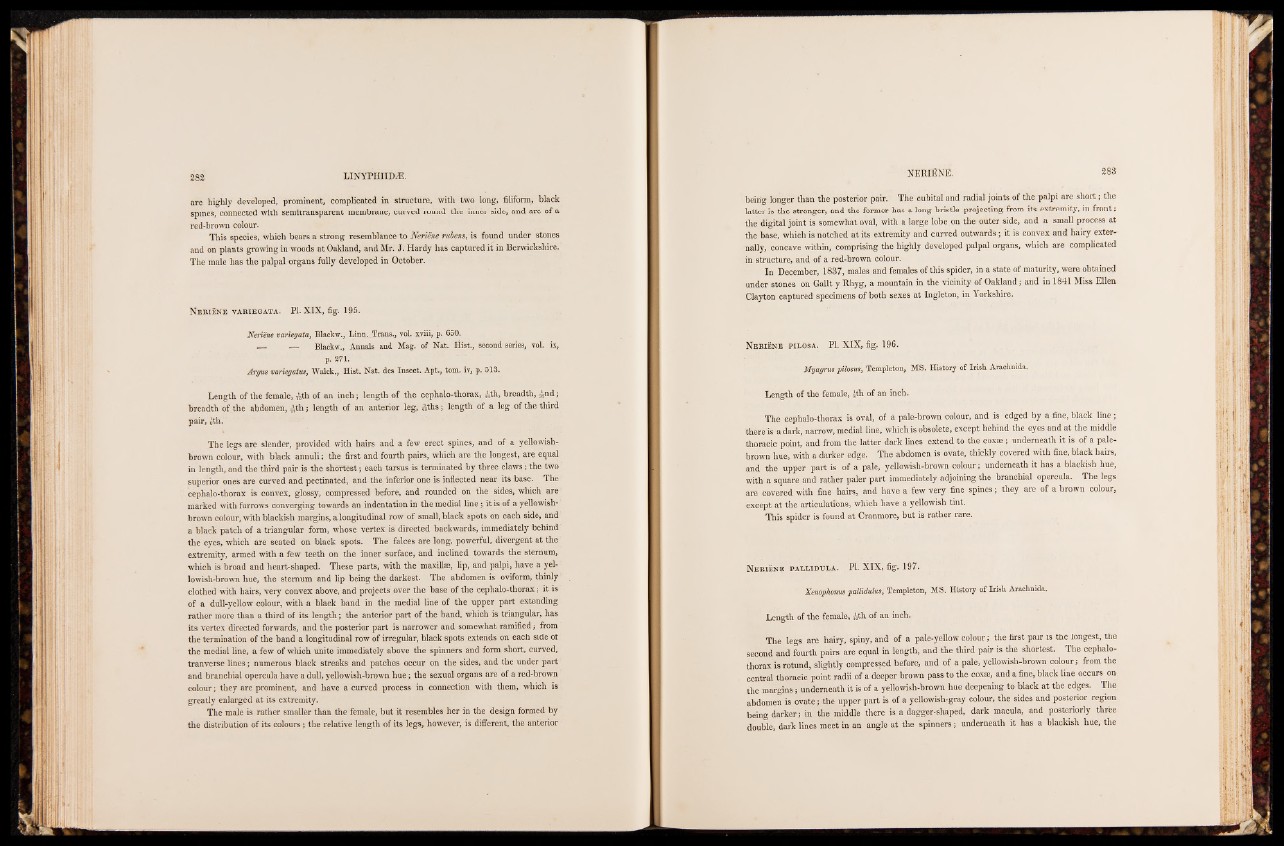
are highly developed, prominent, complicated in structure, with two long, filiform, black
spines, connected with semitransparent membrane, curved round the inner side, and are of a
red-brown colour.
This species, which bears a strong resemblance to Neriene rubens, is found under stones
and on plants growing in woods at Oakland, and Mr. J. Hardy has captured it in Berwickshire.
The male has the palpal organs fully developed in October.
Neriene variegata. PI. XIX, fig. 195.
Neriene variegata, Blackw., Linn. Trans., vol. xviii, p. 650.
__ — Blackw., Annals and Mag. of Nat. Hist., second series, vol. ix,
p. 271.
Argus variegatus, Walck., Hist. Nat. des Insect. Apt., tom. iv, p. 513.
Length of the female, ^th of an inch; length of the cephalo-thorax, 55th, breadth, ^nd;
breadth of the abdomen, 53th ; length of an anterior leg, ^ths; length of a leg of the third
pair, gth.
The legs are slender, provided with hairs and a few erect spines, and of a yellowish-
brown colour, with black annuli; the first and fourth pairs, which are the longest, are equal
in length, and the third pair is the shortest; each tarsus is terminated by three claws; the two
superior ones are curved and pectinated, and the inferior one is inflected near its base. The
cephalo-thorax is convex, glossy, compressed before, and rounded on the sides, which are
marked with furrows converging towards an indentation in the medial lin e ; it is of a yellowish-
brown colour, with blackish margins, a longitudinal row of small, black spots on each side, and
a black patch of a triangular form, whose vertex is directed backwards, immediately behind
the eyes, which are seated on black spots. The falces are long, powerful, divergent at the
extremity, armed with a.few teeth on the inner surface, and inclined towards the sternum,
which is broad and heart-shaped. These parts, with the maxillae, lip, and palpi, have a yellowish
brown hue, the sternum and lip being the darkest. The abdomen is oviform, thinly
clothed with hairs, very convex above, and projects over the base of the cephalo-thorax; it is
of a dull-yellow colour, with a black band in the medial line of the upper part extending
rather more than a third of its length; the anterior part of the band, which is triangular, has
its vertex directed forwards, and the posterior part is narrower and somewhat ramified; from
the termination of the band a longitudinal row of irregular, black spots extends on each side of
the medial line, a few of which unite immediately above the spinners and form short, curved,
tranverse lines; numerous black streaks and patches occur on the sides, and the under part
and branchial opercula have a dull, yellowish-brown hue; the sexual organs are of a red-brown
colour; they are prominent, and have a curved process in connection with them, which is
greatly enlarged at its extremity.
The male is rather smaller than the female, but it resembles her in the design formed by
the distribution of its colours; the relative length of its legs, however, is different, the anterior
being longer than the posterior pair. The cubital and radial joints of the palpi are short; the
latter is the stronger, and the former has a long bristle projecting from its extremity, in front;
the digital joint is somewhat oval, with a large lobe on the outer side, and a small process at
the base, which is notched at its extremity and curved outwards; it is convex and hairy externally,
concave within, comprising the highly developed palpal organs, which are complicated
in structure, and of a red-brown colour.
In December, 1837, males and females of this spider, in a state of maturity, were obtained
under stones on Gallt y Rhyg, a mountain in the vicinity of Oakland; and in 1841 Miss Ellen
Clayton captured specimens of both sexes at Ingleton, in Yorkshire.
Neriëne pilosa. PL XIX, fig. 196.
Myagrus pilosus, Templeton, MS. History of Irish Arachnida.
Length of the female, |th of an inch.
The cephalo-thorax is oval, of a pale-brown colour, and is edged by a fine, black line ;
there is a dark, narrow, medial line, which is obsolete, except behind the eyes and at the middle
thoracic point, and from the latter dark lines extend to the coxæ ; underneath it is of a pale-
brown hue, with a darker edge. The abdomen is ovate, thickly covered with fine, black hairs,
and the upper part is of a pale, yellowish-brown colour ; underneath it has a blackish hue,
with a square and rather paler part immediately adjoining the branchial opercula. The legs
are covered with fine hairs, and have a few very fine spines; they are of a brown colour,
except at the articulations, which have a yellowish tint.
This spider is found at Cranmore, but is rather rare.
Neriëne pallidula. PI. XIX, fig. 197.
Xenophonus pallidulus, Templeton, MS. History of Irish Arachnida.
Length of the female, rèth of an inch.
The legs are hairy, spiny, and of a pale-yellow colour ; the first pair is the longest, the
second and fourth pairs are equal in length, and the third pair is the shortest. The cephalo-
thorax is rotund, slightly compressed before, and of a pale, yellowish-brown colour; from the
central thoracic point radii of a deeper brown pass to the coxæ, and a fine, black line occurs on
the margins ; underneath it is of a yellowish-brown hue deepening to black at the edges. The
abdomen is ovate; the upper part is of a yellowish-gray colour, the sides and posterior region
being darker; in the middle there is a dagger-shaped, dark macula, and posteriorly three
double, dark lines meet in an angle at the spinners ; underneath it has a blackish hue, the